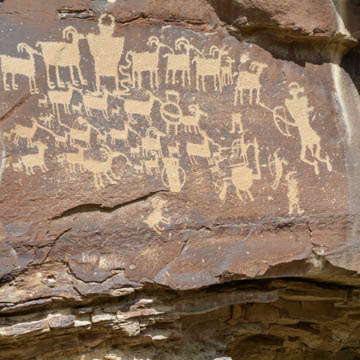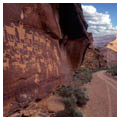Nine Mile Canyon, which houses thousands of beautifully executed Native American panels, is one of the best-known and most accessible rock art sites in Utah. Several distinct art styles are present here, intimating that the area was occupied by different cultures over time. The oldest and the two rarest panels of petroglyphs belong to the Desert Culture, which extended from 5000 BCE to 500 CE; the most common, with 60 petroglyphs, is Fremont style, dating from 900 to 1250 CE.
In 1979 and 1993, the Archaeology Department at Brigham Young University published two extensive surveys of the area that documented the petroglyphs and pictographs present in the canyon, as well as the alarming vandalism of these artworks by white settlers and visitors. The 1979 archaeological survey recorded 117 rock art sites, some of which include architectural remains and others that were likely associated with structures that are no longer extant. The 1993 survey recorded 66 panels among 151 prehistoric sites that consist primarily of dwellings, storage facilities, rock art panels, cairns, rock alignments, and ephemeral rock walls of undetermined utility. These ruins are located near permanent sources of water, arable lands, and pinyon-juniper groves.
Both teams of archaeologists found that the frequency and distribution of rock sites corresponded with the distribution of architectural sites generally associated with formative agriculturalists. This could mean either that most rock art in this area was a direct consequence of adjacent semi-sedentary agricultural activities, or that the available natural resources in this canyon made these areas attractive to both farmers and hunter-gatherers, both of whom engaged in rock art practices.
In the area with the densest concentration of petroglyphs and pictographs, most of the large, impressive panels are located on the lowest cliff face and generally their density decreases with height; some major panels, however, are located quite high on the cliff. The artworks are often grouped around the mouths of side canyons, suggesting that Fremont habitations tended to cluster near canyon mouths. The preponderance of sites along cliff faces next to the canyon bottom suggests that those moving up and down the canyon bottom were the intended observers of rock art.
The rock art of the Fremont culture encompasses a broad range of subjects such as animals, anthropomorphs, and unidentified abstractions, including, for example, lines, snake-shaped patterns, and fields of dots. Anthropomorphs and quadrupeds are sometimes depicted in fantastic styles; the former are often depicted with a trapezoidal or rectangular torso, while the latter frequently have ovoid or rectangular bodies. This common Fremont style is present in virtually every site in the canyon. One of the unifying elements of the style is its diversity; it suggests an art tradition that encouraged experimentation and innovation rather than conformity to a strict canon.
The Fremont panels, produced between 700 and 1250 CE, largely feature hunting scenes, wherein hunters are depicted pursuing game animals, especially bighorn sheep, and to a lesser extent elk, deer, and birds. These images provide insight into the hunting strategies of Native Americans in Nine Mile Canyon and also reflect the artists’ detailed knowledge of the animals. Scenes show rams, ewes, and yearlings together, which occurs only once a year during the rut; animals are shown in hierarchical order by size; and rams contest one another in a display of dominance. These etchings also reveal that hunting for deer and pronghorns was often a communal affair in which a corral was constructed of brush and rocks to capture and kill the animals.
The Utes, a Native American tribe that give the state its name and who occupied this area from 1700–1875 CE, created only four panels in this entire stretch. Most of these petroglyphs are scratched or lightly pecked, but some are pecked deeply, presumably by a sharp stone; they depict horses, an owl, a tepee, and a deer-hunting scene, respectively. The Ute or Numic hunting scene is distinguished from the earlier scenes with its inclusion of horsemen, which is not found in Native cultures before contact with the Spaniards.
In the later nineteenth century, Anglo settlers began to leave their own marks on the walls of the canyon. Most of these are written on sandstone with axle grease from freight wagons. Names, initials, dates, and some graffiti mark the path of the present-day travelers through the canyon. They raise special problems for preservationists about where to draw the line between art and vandalism. In the 1880s, Utah experienced a dramatic population explosion that made the canyon a major transport corridor, and settlers established ranches and homesteads in the area. The visibility of the rock art from Nine Mile Canyon Road made it a popular and heavily trafficked area throughout the twentieth century. At the turn of the twenty-first century, the discovery of rich deposits of natural gas deep beneath the Tavaputs Plateau attracted oil and gas companies to the area and the canyon became a thoroughfare for industrial trucks. Protests from environmental and preservation agencies have been ineffectual and Nine Mile Canyon was listed on the National Trust for Historic Preservation’s America’s Most Endangered Places list in 2004. The rock art continues to be exposed to a large amount of dust produced by constant industrial traffic.
References
Hurst, Winston. Survey of rock art in the central portion of Nine Mile Canyon, Eastern Utah. Provo, UT: BYU Printing Service, 1979.
Loendorf, Lawrence. “Categories and Conundrums: The Rock Art of Lower Nine Mile Canyon.” In New Dimensions in Rock Art Studies, edited by Ray T. Matheny, et al. Provo, UT: Brigham Young University, 2004.
Spangler, Jerry D. “Hunting Strategies and Winter Economy of the Fremont as Revealed in the Rock Art of Nine Mile Canyon.” In New Dimensions in Rock Art Studies, edited by Ray T. Matheny, et al. Provo, UT: Brigham Young University, 2004.

















